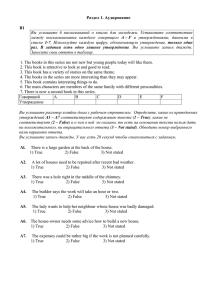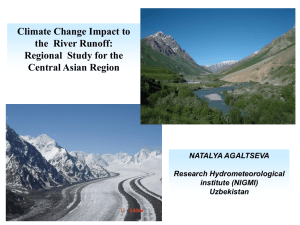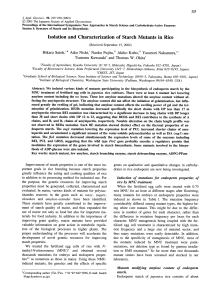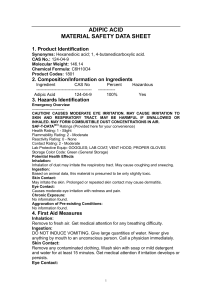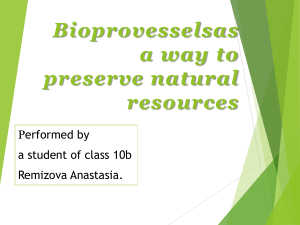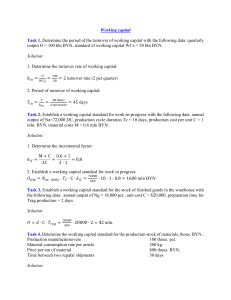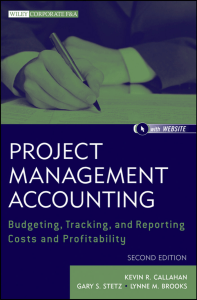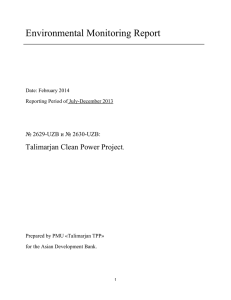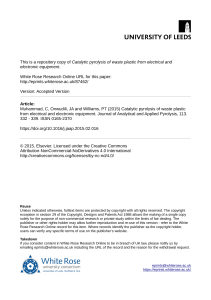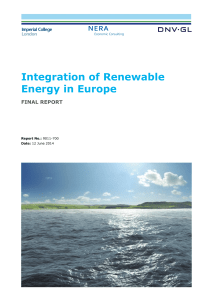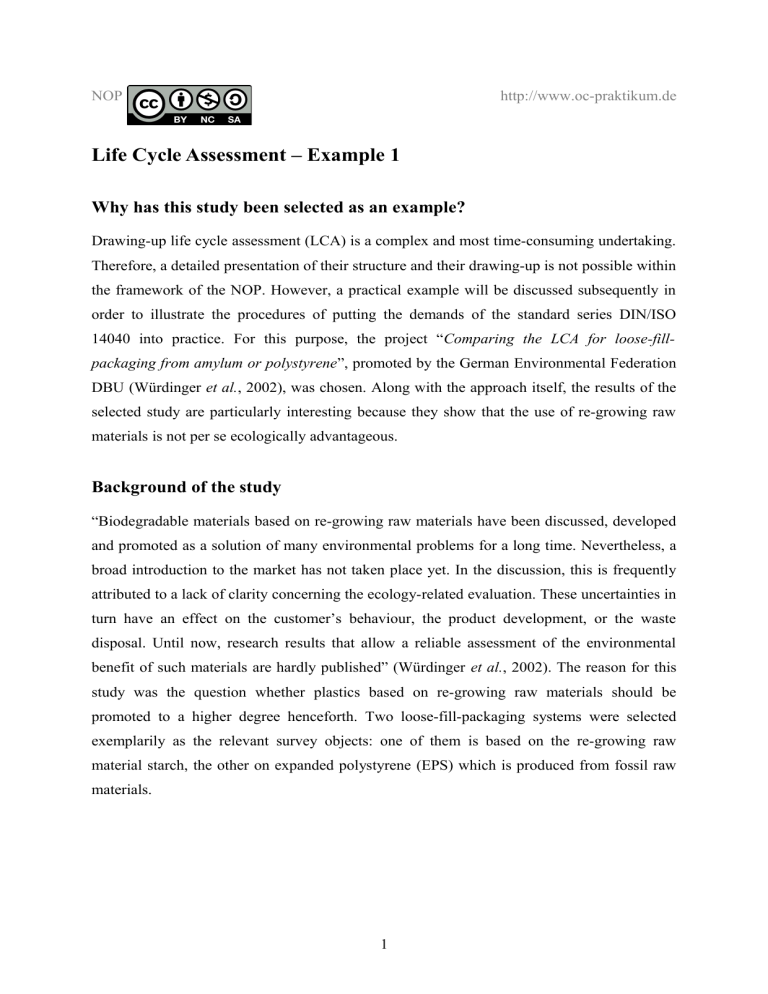
NOP http://www.oc-praktikum.de Life Cycle Assessment – Example 1 Why has this study been selected as an example? Drawing-up life cycle assessment (LCA) is a complex and most time-consuming undertaking. Therefore, a detailed presentation of their structure and their drawing-up is not possible within the framework of the NOP. However, a practical example will be discussed subsequently in order to illustrate the procedures of putting the demands of the standard series DIN/ISO 14040 into practice. For this purpose, the project “Comparing the LCA for loose-fillpackaging from amylum or polystyrene”, promoted by the German Environmental Federation DBU (Würdinger et al., 2002), was chosen. Along with the approach itself, the results of the selected study are particularly interesting because they show that the use of re-growing raw materials is not per se ecologically advantageous. Background of the study “Biodegradable materials based on re-growing raw materials have been discussed, developed and promoted as a solution of many environmental problems for a long time. Nevertheless, a broad introduction to the market has not taken place yet. In the discussion, this is frequently attributed to a lack of clarity concerning the ecology-related evaluation. These uncertainties in turn have an effect on the customer’s behaviour, the product development, or the waste disposal. Until now, research results that allow a reliable assessment of the environmental benefit of such materials are hardly published” (Würdinger et al., 2002). The reason for this study was the question whether plastics based on re-growing raw materials should be promoted to a higher degree henceforth. Two loose-fill-packaging systems were selected exemplarily as the relevant survey objects: one of them is based on the re-growing raw material starch, the other on expanded polystyrene (EPS) which is produced from fossil raw materials. 1 NOP http://www.oc-praktikum.de Fig. 1: Loose Fill Packaging Goal and scope definition Goal The examination of a practically relevant example will show whether the use of plastics versus re-growing raw materials is ecologically reasonable or not. The following loose-fillpackaging systems were selected as examples: package systems on the basis of expanded polystyrenes (EPS) package systems on the basis of expanded starch (re-growing raw material) package systems on the basis of recycling material (recycling polystyrene) Variation 3 (package systems based on recycling material) will not be considered in the following in order to guarantee the clarity of the practical example and to restrict this presentation’s scope. Function and Functional Unit The usability of the examined product systems as filling material for transportation packages was considered as their function. During the examination it was assumed that the different product systems do not differ in their technical qualities. The volume of the loose-fillpackaging was chosen as a functional unit of the balancing. All data and results refer to a packaging volume of 100 m³. 2 NOP http://www.oc-praktikum.de System boundary The system boundary demarcates the object of investigation from the environment. The system borders were chosen “from the cradle to the grave”. That means that all relevant material and energy flows are considered, starting from the exploration of the raw materials, exploitation, transportation and pre-procedures to the production process and the use of the product systems, and finally the waste disposal. Cut-off Criteria (Detail Limits) In the survey, all material and energy flows of a considered process amounting to less than 1 % in relation to the mass of the desired output were cut off. The sum of the cut-off processes was not allowed to exceed 5 % of the desired output. Material flows with a share of less than 1 % in relation to the mass of the desired output were nevertheless considered, if they were interesting for the entire LCA with regard to toxic or energetic aspects. Geographical and time boundaries The political borders of the Federal Republic of Germany form the reference area of this study. If materials (for example petroleum) are provided in other countries, the country of origin is the reference area. The material is evaluated with regard to the respective market share of the material in Germany. 1997 was chosen as the reference year. How was the Inventory Analysis drawn up? Calculated scenarios A series of different scenarios was set up and calculated in order to meet the goals of the study, i.e. to answer the question for the reasonability of using plastics based on re-growing raw materials. Such scenarios are important for considering the influence of different factors on the system in question. Concerning the loose-fill-packaging from expanded starch, 20 different scenarios were examined. Table 1 shows a selection of the examined scenarios. 3 NOP Production Utilization http://www.oc-praktikum.de Maize starch Single Potato starch II Wheat starch (seeping of the (conventionally total sewage) produced wheat) Single utilization Single utilization Disposal utilization Maize starch Wheat, extensive Internal recycling Internal (fourfold recycling utilization) (twofold recording with recording with recording with recording with utilization) recording with remnant waste remnant waste remnant waste remnant waste biowaste and and mixed and mixed waste and mixed and mixed waste composting waste collection collection collection waste collection Table 1: Selection of examined scenarios– loose-fill-packaging from expanded starch Partial Processes of a Process Scenario Similar to the area of loose-fill-packaging from expanded starch, scenarios for expanded polystyrene that differed in partial areas were examined. As an example for these scenarios, the manufacture of packaging from primary polystyrene (EPS) is shown (figure 2) in the following. A single utilization of the loose-fill-packaging, a subsequent waste disposal via the recycling yard, and a material-oriented recycling were assumed for the presented scenario. 4 NOP http://www.oc-praktikum.de Raw material aquisition Production of styrenebutadiene rubber (SBR) Production of primary polystyrene (GPPS) Production of pentane/ butane Production of polystyreneloose-fill Distribution/sales Usuage (single) Packer Recipient Deduction output Disposal Production GPPS (matrix) Recording according to type Recycling yard, regranulation GPPS Fig. 2: Partial processes of an EPS-scenario In order to clarify the system boundary, the production of primary polystyrene is shown in detail in figure 3. 5 NOP http://www.oc-praktikum.de Exploitation of natural gas Hydrocarbon source Processing of natural gas Ethylene production Benzene production Naphta Ethylene Benzene Exploitation of crude oil Distillation to naphta Reformation to benzene Benzene Production of ethylbenzene Production of styrene Polymerization of styrene Primary polystyrene Fig. 3: Flow chart - production of primary polystyrene How to proceed with the data capture? The relevant material and energy flows of the partial processes required for the final product were collected in order to establish the “heart” of the LCA - the inventory analysis. The process-specific input and output data were derived and worked up, and afterwards the results were recorded and calculated. The guidelines, cut-offs, and limitations, defined in the step of the goal and scope definition, were either met or adjusted according to the requirements resulting from the available data set. Then, the impact assessment was carried out on the base of the results of the inventory analysis. 6 NOP http://www.oc-praktikum.de The Evaluation According to the guidelines of the ISO 14042 standard, the impact assessment of a LCA consists of the three parts: Selection of the impact categories to be considered Assignment of the inventory analysis results to the impact categories (classification) Calculation of the impact indicator results (characterization) In this study the following impact categories were considered: Selected Impact Categories Global warming Stratospheric ozone depletion Tropospheric photochemical ozone creation Eutrophication Acidification Human toxicity Ecotoxicity Abiotic resource depletion Land use Table 2: Considered impact categories Following the selection of the impact categories, the parameters determined in the inventory analysis like the carbon dioxide or methane emissions have to be assigned to their different environmental effects. Classification The inventory analysis parameters assigned to an impact category have to be transferred to a common unit of measurement in the course of classification. One inventory analysis parameter can be assigned to different impact categories. Global warming Ozone depletion CO2, CH4, N2O N2O 7 NOP Photochemical ozone creation Eutrophication Acidification Human toxicity Ecotoxicity Abiotic resource depletion Land use http://www.oc-praktikum.de Benzene, CH4, NOx, Formaldehyd, NMVOC, VOC, pentane, butane NOX, NH3, P-ges., CSB, N-ges., NH4, Nitrate H2S,HCl, HF, NH3, NOX, SO2 As, BaP, benzene, Cd, Cr, PCDD/F, Ni, Pb, SO 2, diesel particles, biocides AOX, chloride, NH4+, H2S, HF, NH3, NOx, SO2 Crude oil, natural gas, brown coal, hard coal Area Table 3: Classification Characterization One of the tasks of the characterization is to transfer those mass or energy balance parameters which are assigned to one impact category into common units of measurement. This is necessary because the different materials’ contribution to an environmental effect differ considerably. For example, methane has an approximately 25 times higher global warming potential than carbon dioxide, and the global warming potential of laughing gas N2O is even 320 times higher than that of CO 2. In the next step, the indicator results have to be formed from the changed inventory analysis results. At last, the results must be evaluated. The results of the study No clear ecological advantage could be determined for a single product on the basis of the chosen scenarios within the LCA. Subsequently, some results of the study are introduced as examples. The waste disposal is important The comparison between the starch and the EPS scenarios shows clearly that the application of the term “CO2-neutral”, which is used synonymously with the neutrality concerning the global warming, does not principally apply to starch-loose-fill-packaging from re-growing raw materials, although it actually might be achieved. However, this is only possible if specific prerequisites are fulfilled. Above all, an energetic or raw-material utilization of the used starch-loose-fill-packaging inevitably has to take place. A material utilization is not 8 NOP http://www.oc-praktikum.de practicable. Otherwise, a disposal in a waste disposal site would lead to emissions of the green house gas methane. Additionally, a renunciation of additives based on fossil raw material has a positive effect. This aspects together, a utilization of the used product and a renunciation of additives, can lead to slightly reductions concerning the global warming potential. An increased use of further regenerative energy sources would improve this result. The recycling of the packaging clearly reduces the environmental impact Independent from the material, the recycling of the loose-fill-packaging is a very effective measure in order to reduce the adverse impacts into the environment which are connected with the use of this type of packaging. On the one hand, the sales- and utilization phase makes only small contributions to the results of the impact assessment. Accordingly, the savings in material consumption and the reduced expenditures due to recycling in the loose-fillpackaging production contribute directly to the results. The same applies for the reduction of the waste quantities which is noticeable in almost all cases. On the other hand, the beneficial influence of the recycling of loose-fill-packaging must also be attributed to the fact that this kind of packaging can be recycled without cleaning and without or with only relatively low transportation costs -- unlike beverage packaging, for example. All in all, for almost all indicators a twofold recycling leads to a halving of the results, and a quadruple recycling leads to a quartering.. Comparison of the EPS- and starch scenarios There are very clear differences between the different scenarios for the use of loose-fillpackaging concerning their environmental effects. However, fundamental advantages emerge neither from the utilization of starch nor from that of polystyrene. The concrete forms of the material preparation as well as the waste disposal are highly important for the ecological impact. Concerning the disposal step, a decisive factor is e.g. the additional energetic benefit from a thermal utilization. Consequently, it is not the origin of the raw materials which is crucial for the environmental relevance of the scenarios, but the type of the processes combined in the respective lifespan. Obviously, there are very good EPS- as well as starch scenarios. Apart from that in both cases are scenarios conceivable which appear clearly more unfavorably. The variation width 9 NOP http://www.oc-praktikum.de between material-identical scenarios is similar to that within the totality of the scenarios. Independent from the material type, there are considerable optimization potentials. The starch scenarios may perform similarly well as the good EPS-scenarios only if the loose-fillpackaging is energetically recycled. Biological degradability as an advantage? The biodegradability of the loose-fill-packaging based on starch is not a material property which is necessary for the product purpose. Its advantage is to be seen in the area of the waste disposal. However, it has a positive effect only if the starch-loose-fill-packaging is microbially fermented to biogas and afterwards energetically used with high efficiencies. Composting is a further way of disposal which depends on the biological degradability. This way turns out to be unfavourable in comparison to an energetic utilization. The results very clearly show that the biological degradability alone does not suffice as a criterion for the environmental compatibility and sustainability of a material or product. Crucial are rather the concrete way of the product’s disposal after use and the effect the biological degradability has on the ecological sustainability of the product. However, this outcome may be changed if the biological degradability is an essential material property. In view of these results, the authors nevertheless raise the question whether it would be a worthwhile aim to develop plastics from re-growing raw materials which are not biodegradable but durable. Such plastics might be used many times and can finally be energetically recycled. References Würdinger, E., Roth, U., Wegener, A., 2000. Kunststoffe aus nachwachsenden Rohstoffen: Vergleichende Ökobilanz für Loose-fill-Packmittel aus Stärke bzw. Polystyrol. DBU-Az. 04763. 10
